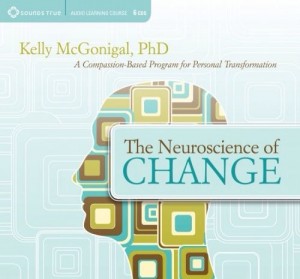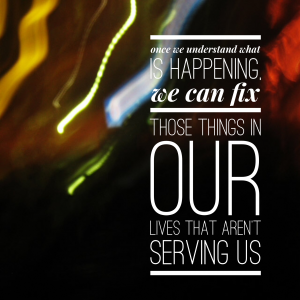Anyone who says that the issue of obesity, weight management and fitness is all about knowing what is/is not good for you, or about willpower is over-simplifying the problem, and hasn’t fully grasped the gravity of the issue. It is a hugely complex issue because it all starts in the brain, and the brain is a hugely complex organism.
We all do things that we know don’t serve us in our goals, and yet, we often find ourselves powerless to change. It doesn’t matter if we’re talking about eating habits, spending money, smoking, or some other habit that we want to change.

In Kelly McGonigal’s audio program, The Neuroscience of Change, she talks about our destructive habits. Destructive habits are things that we do that either don’t serve us any longer, or are getting in the way of things we do want in our lives. It could be smoking, eating too much, or overspending. We all have things that we do, that we ask ourselves, “Why did I do that? I know better.”
What we don’t often acknowledge is that we started the destructive habit for a reason. At some point, performing that action served us in our goal – whether it was to soothe us, reduce anxiety, avoid discomfort, or numb our pain. And maybe, looking back, it doesn’t make a lot of sense now, but it probably did at the time.
What’s going on with our brain
When we start habits, we make conscious decisions. We think about it, and are aware of what we are doing. It’s intentional. Think about a time in your life when you learned a new habit, whether it was learning to recycle, driving, or even cooking a new recipe. The process took a lot of concentration and effort.
But our brains don’t really like to think. Thinking takes a lot of effort, and energy. All of our decision-making and critical thought takes place in a part of the brain called the prefrontal cortex.
What the brain is really good at is seeing sequences and patterns. When the brain starts to see similarities in sequences, or situations, it intuitively recognizes the pattern. It’s as if the brain is saying, “Oh, I’ve seen this before. We resolved it by doing X. That seemed to work well, so we’ll do that again.” It’s connecting the dots for us without us even being aware that there are any dots.
At this point, the point at which we are unconsciously making decisions, the brain has taken that sequence, and moved it out of the prefrontal cortex, into a part of the brain called the basal ganglia, aka our habit center. The brain thinks it’s doing us a favor! We no longer have to think about it! It is saving us so much time not to have to think about how to soothe ourselves when we are feeling hurt and rejected, or the sounds of an approaching saber-toothed tiger.
 And I think this is fascinating because once we understand what is happening, then we can fix those things in our lives that aren’t serving us. We can be aware of our true motivations, and drivers for our actions. We can become more aware participants in our lives.
And I think this is fascinating because once we understand what is happening, then we can fix those things in our lives that aren’t serving us. We can be aware of our true motivations, and drivers for our actions. We can become more aware participants in our lives.
I am an introvert. I am also a procrastinator. I have been most of my life. I mean, really, why not put off what you can do today. It has always frustrated me though, and I’ve always wondered why do I do this? There have been so many times that I’ve put myself at a disservice due to my procrastination. I’ve always wondered why I do that. So let’s take my procrastination as an example.
Because I am an introvert, I am uncomfortable initiating conversations with people I don’t know. I didn’t realize why I was always reluctant to return phone calls. Some of these calls were even from potential clients who wanted to give me money! Why would I do that? It wasn’t until I heard Kelly McGonigal explain it that it all made sense. I was avoiding the anxiety I thought I would experience in making that call. All of these disaster scenarios in my head: What if it went poorly? What if they didn’t like me? What if I wasn’t able to help them? What if they found out that I didn’t really know what I was doing? What if…? I was self-soothing by avoiding that which made me anxious. I had done it for years.
Okay, so how do we get rid of the habit that isn’t serving us? There are a few steps that we need to take. It takes some time, and it is uncomfortable, but if you really want to get rid of it, this technique works. I’ve used it in my life, and on many of my habits that I wanted to retrain.
What you are essentially doing here is starting at the end, and moving your way forward through the dots to get to a place of prevention: before the dots even happen
Step 1: Acknowledge it
The first step in changing your destructive habit is acknowledging that this habit isn’t serving you in your goals.
Step 2: Mindful Mindlessness
Second, you want to become aware of the habit as you are in it. It is crucial that during this time that you do not become self-critical, but rather approach the situation with curiosity. Pay attention to how it happens, and become aware of the impulse.
Step 3: Awareness of what triggers the impulse
You are most likely to feel this impulse in this situation, under these circumstances: Sad, anxious, when someone presses a button. We can use this to start to trigger a different habit, goal or set of behaviors.
Step 4: Create an Alternative
When you have identified what triggers lead to your destructive habit, visualizing how you will react differently can help retrain your brain. In your visualization, try to imagine everything that you can: the conversation, how you feel physically, your thoughts, and what you will do. It’s like a dress rehearsal for your brain to learn the new habit.
A Caveat:
Self-Compassion, or the act of treating yourself as you would treat a close friend, will aid in moving you through this process. Having negative self-talk, or shaming ourselves, about what we should or should not have done has been repeatedly shown, to not work in producing our desired behavior. So, try to talk to yourself as you would a friend in the same situation.
Additionally, mindfulness training (aka: meditation) is helpful in overcoming automatic habits, mainly because when we become aware of our actions, thoughts and feelings, we can make conscious decisions, versus relying on our brain to connect the dots for us.